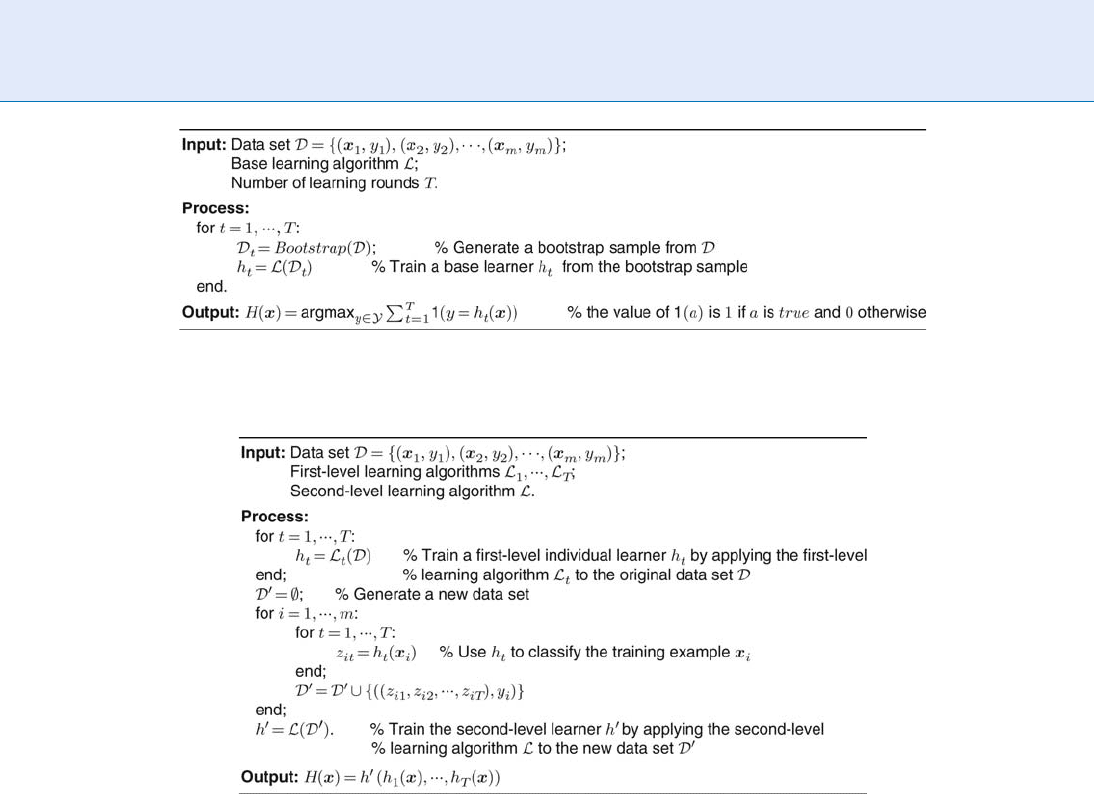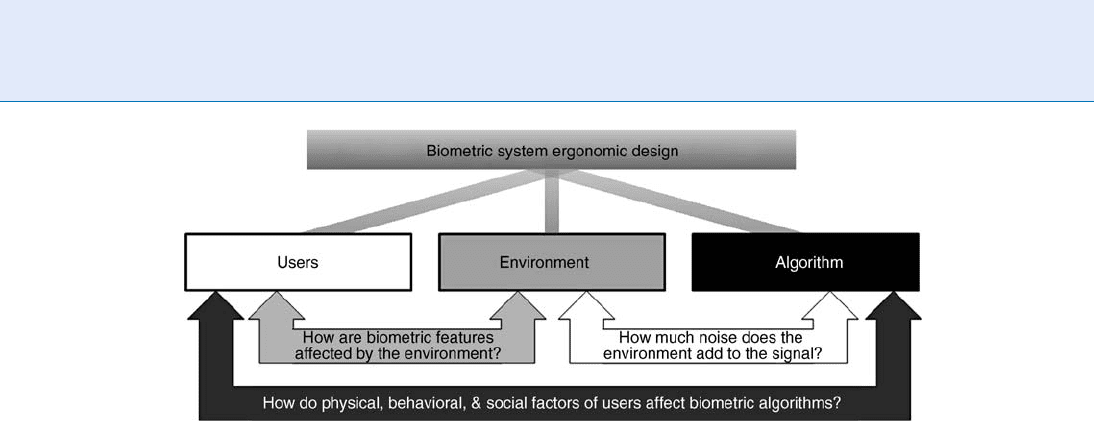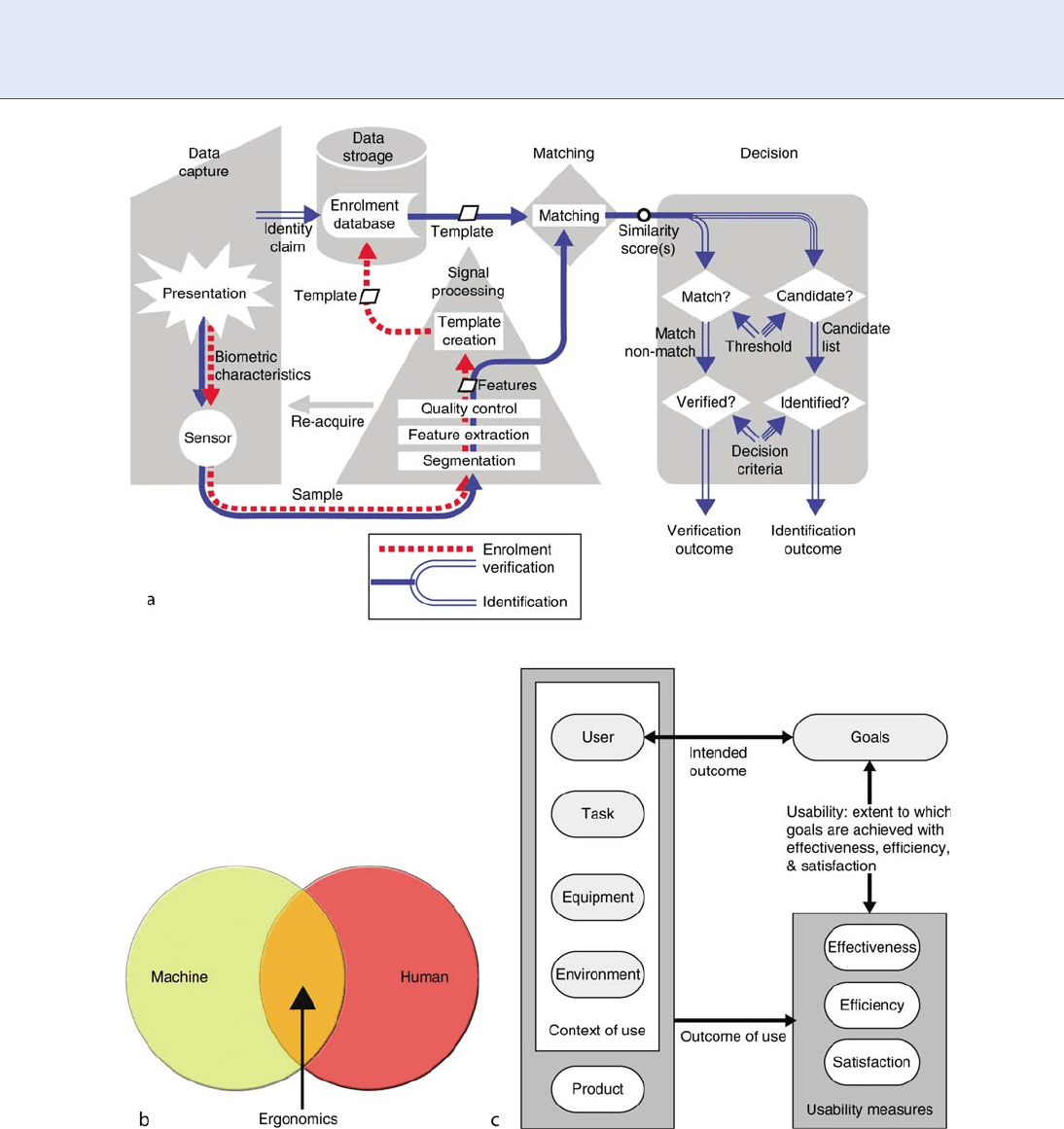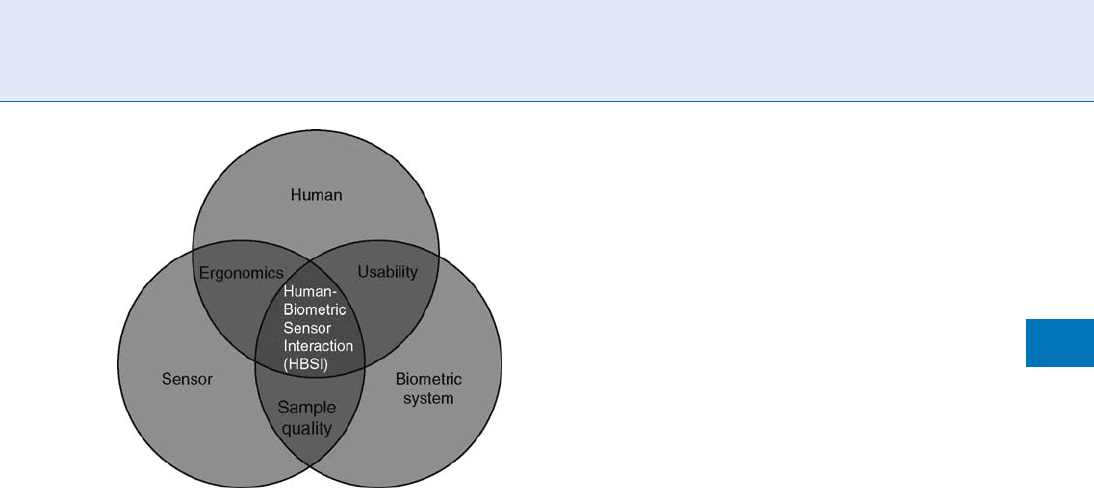Li S.Z., Jain A.K. (eds.) Encyclopedia of Biometrics
Подождите немного. Документ загружается.


Ensemble Learning
ZHI-HUA ZHOU
National Key Laboratory for Novel Software
Technology, Nanjing University, Nanjing, China
Synonyms
Committee-based learning; Multiple classifier systems;
Classifier combination
Definition
Ensemble learning is a machine learning paradigm
where multiple learners are trained to solve the same
problem. In contrast to ordinary machine learning
approaches which try to learn one hypothesis from
training data, ensemble methods try to construct a set
of hypotheses and combine them to use.
Introduction
An ensemble contains a number of learners which
are usually called base learners. The
▶ generalization
ability of an ensemble is usually much stronger than
that of base learners. Actually, ensemble learning is
appealing because that it is able to boost weak learners
which are slightly better than random guess to strong
learners which can make very accurate predictions.
So, ‘‘base learners’’ are also referred as ‘‘weak learners’’.
It is noteworthy, however, that although most theo-
retical analyses work on weak learners, base learners
used in practice are not necessarily weak since using
not-so-weak base learners often results in better
performance.
Base learners are usually generated from training
data by a base learning algorithm which can be decision
tree, neural network or other kinds of machine
learning algorithms. Most ensemble methods use a
single base learning algorithm to produce homogeneous
base learners, but there are also some methods which
use multiple learning algorithms to produce heteroge-
neous learners. In the latte r case there is no single base
learning algorithm and thus, some people prefer call-
ing the learners individual learners or component lear-
ners to ‘‘base learners’’, while the names ‘‘individual
learners’’ and ‘‘component learners’’ can also be used
for homogeneous base learners.
It is difficult to trace the starting point of the
history of ensemble methods since the basic idea of
deploying multiple models has been in use for a long
time, yet it is clear that the hot wave of research on
ensemble learning since the 1990s owes much to two
works. The first is an applied research conducted by
Hansen and Salamon [1] at the end of 1980s, where
they found that predictions made by the combination
of a set of classifiers are often more accurate than
predictions made by the best single classifier. The sec-
ond is a theoretical research conducted in 1989, where
Schapire [2] proved that weak learners can be boosted
to strong learners, and the proof resulted in Boosting,
one of the most influential ensemble methods.
Constructing Ensembles
Typically, an ensemble is constructed in two steps.
First, a number of base learners are produced, which
can be generated in a parallel style or in a sequential
style where the generation of a base learner has influ-
ence on the generation of subsequent learners. Then,
the base learners are combined to use, where among
the most popular combination schemes are majority
voting for classification and weighted averaging for
regression.
Generally, to get a good ensemble, the base learners
should be as more accurate as possible, and as more
diverse as possible. This has been formally shown
by Krogh and Vedelsby [3], and emphasized by
many other people. There are many effective proces-
ses for estimating the accuracy of learners, such as
▶ cross-validation, hold-out test, etc. However, there
is no rigorous definition on what is intuitively per-
ceived as diversity. Although a number of diversity
measures have been desig ned, Kuncheva and Whitaker
[4] disclosed that the usefulness of existing diversity
measures in constructing ensembles is suspectable. In
practice, the diversity of the base learners can be intro-
duced from different channels, such as subsampling
the training examples, manipulating the attributes,
manipulating the outputs, injecting randomness into
learning algorithms, or even using multiple mechan-
isms simultaneously. The em ployment of different base
learner generation processes and/or different combina-
tion schemes leads to different ensemble methods.
There are many effective ensemble methods. The
following will briefly introduce three representative
methods, Boosting [2, 5], Bagging [6] and Stacking
270
E
Ensemble Learning

[7]. Here, binary classification is considered for
simplicity. That is, let X and Y denote the insta-
nce space and the set of class labels, respectively,
assuming Y¼f1; þ1g. A trainin g data set
D¼fðx
1
; y
1
Þ; ðx
2
; y
2
Þ; ; ðx
m
; y
m
Þg is given, where
x
i
2Xand y
i
2Y(i¼1,...,m).
Boosting is in fact a family of algorithms since there
are many variants. Here, the most famous algor ithm,
AdaBoost [5], is considered as an example. First, it
assigns equal weights to all the trainin g examples.
Denote the distribution of the weights at the t-th
learning round as D
t
. From the training data set and
D
t
the algorithm ge nerates a base learner h
t
: X!Y
by calling the base learning algorithm. Then, it uses
the training examples to test h
t
, and the weights of the
incorrectly classified examples will be increased. Thus,
an updated weight distribut ion D
tþ1
is obtained. From
the training data set and D
tþ1
AdaBoost generates
another base learner by calling the base learning
algorithm again. Such a process is repeated for T
times, each of which is called a round, and the final
learner is derived by weighted majority voting of the T
base learners, where the weights of the learners are
determined during the training process. In practice,
the base learning algorithm may be a learning algo-
rithm which can use weighted training examples di-
rectly; other wise the weights can be exploited by
sampling the training examples according to the
weight distribution D
t
. The pseudo-code of AdaBoost
is shown in Fig.1.
Bagging [6] trains a number of base learners each
from a different bootstrap sample by calling a base
learning algorithm. A bootstrap sample is obtained
by subsampling the training data set with replacement,
where the size of a sample is as the same as that of the
training data set. Thus, for a bootstrap sample, some
training examples may appear but some may not,
where the probability that an example appears at least
once is about 0.632. After obtaining the base learners,
Bagging combines them by majority voting and the
most-voted class is predicted. The pseudo-code of
Bagging is shown in Fig.2. It is worth mentioning
that a variant of Bagging, Random Forests [8], has
been deemed as one of the most powerful ensemble
methods up to date.
In a typical implementation of Stacking [7], a
number of first-level individual learners are genera-
ted from the training data set by employing different
learning algorithms. Those individual learners are then
combined by a second-level learner which is call ed as
meta-learner. The pseudo-code of Stacking is shown
in Fig.3. It is evident that Stacking has close relation
with information fusion methods.
Generally speaking, there is no ensemble method
which outperforms other ensemble methods consis-
tently. Empirical studies on popular ensemble methods
can be found in many papers such as [9, 10, 11].
Previously, it was thought that using more base
learners will lead to a better performance, yet
Zhou et al. [12] proved the ‘‘many could be better
than all’’ theorem which indicates that this may not
be the fact. It was shown that after generating a
set of base learners, selecting some base learners
instead of using all of them to compose an ensemble
is a bette r choice. Such ensembles are called selective
ensembles.
Ensemble Learning. Figure 1 The AdaBoost algorithm.
Ensemble Learning
E
271
E

It is worth mentioning that in addition to classifi-
cation and regression, ensemble methods have also
been designed for clustering [13] and other kinds of
machine learning tasks.
Why Ensembles are Superior to Singles
To understand that why the generalization ability of
an ensemble is usually much stronger than that of a
single learner, Dietterich [14] gave three reasons by
viewing the nature of machine learning as searching a
hypothesis space for the most accurate hypothesis. The
first reason is that, the training data might not provide
sufficient information for choosing a single best learner.
For example, there may be many learners perform
equally well on the training data set. Thus , combining
these learners may be a better choice. The second
reason is that, the search processes of the learning
algorithms might be imperfect. For example, even if
there exists a unique best hypothesis, it might be diffi-
cult to achieve since running the algorithms result in
sub-optimal hypotheses. Thus, ensembles can com-
pensate for such imperfect search processes. The third
reason is that, the hypothesis space being searched
might not contain the true target function, while
ensembles can give some good approximation. For
example, it is well-known that the classification
boundaries of decision trees are linear segments paral-
lel to coordinate axes. If the target classification
boundary is a smooth diago nal line, using a single
decision tree cannot lead to a good result yet a good
approximation can be achieved by combining a set of
decision trees. Note that those are intuitive instead of
rigorous theoretical explanations.
There are many theoretical studies on famous en-
semble methods such as Boosting and Bagging, yet
it is far from a clear understanding of the underlying
mechanism of these methods. For example, empiri-
cal observations show that Boosting often does not
Ensemble Learning. Figure 2 The Bagging algorithm.
Ensemble Learning. Figure 3 The Stacking algorithm.
272
E
Ensemble Learning

suffer from ▶ overfitting even after a large number of
rounds, and sometimes it is even able to reduce the
generalization error after the training error has already
reached zero. Although many researchers have studied
this phenomenon, theoretical explanations are still in
arguing.
The
▶ bias-variance decomposition is often used in
studying the performance of ensemble methods [9, 12].
It is known that Bagging can significantly reduce the
variance, and therefore it is better to be applied to
learners suffered from large variance, e.g., unstable lear-
ners such as decision trees or neural networks. Boosting
can significantly reduce the bias in addition to reducing
the variance, and therefore, on weak learners such as
decision stumps, Boosting is usually more effective.
Applications
Ensemble learning has already been used in diverse
applications such as optical character recognition,
text categorization, face recognition, computer-aided
medical diagnosis, gene expression analysis, etc. Actu-
ally, ensemble learning can be used wherever machin e
learning techniques can be used.
Summary
Ensemble learning is a powerful machine learning para-
digm which has exhibited apparent advantages in many
applications. By using multiple learners, the generali-
zation ability of an ensemble can be much better than
that of a single learner. A serious deficiency of current
ensemble methods is the lack of comprehensibility, i.e.,
the knowledge learned by ensembles is not understand-
able to the user. Improving the comprehensibility of
ensembles [15] is an important yet largely understu-
died direction. Another important issue is that cur-
rently no diversity measures is satisfying [4] although
it is known that diversity plays an important role in
ensembles. If those issues can be addressed well, en-
semble learning will be able to contribute more to
more applications.
Related Entries
▶ AdaBoost
▶ Classifier Design
▶ Multiple Experts
▶ Machine-Learning
▶ Multiple Classifier Systems
▶ Probability Distribution
References
1. Hansen, L.K., Salamon, P.: Neural network ensembles. IEEE
Trans. Pattern Analy. Mach. Intell. 12(10), 993–1001 (1990)
2. Schapire R.E.: The strength of weak learnability. Mach. Learn.
5(2), 197–227 (1990)
3. Krogh, A., Vedelsby, J.: Neural network ensembles, cross vali-
dation, and active learning. In: Tesauro, G. Touretzky, D.S.
Leen T.K. (eds.) Advances in Neural Information Processing
Systems 7, pp. 231–238. MIT, Cambridge, MA (1995)
4. Kuncheva, L.I., Whitaker, C.J.: Measures of diversity in classifier
ensembles and their relationship with the ensemble accuracy.
Mach. Learn. 51(2), 181–207 (2003)
5. Freund, Y., Schapire, R.E.: A decision-theoretic generalization of
on-line learning and an application to Boosting. J. Comput. Syst.
Sci. 55(1), 119–139 (1997)
6. Breiman, L.: Bagging predictors. Mach. Learn. 24(2), 123–140
(1996)
7. Wolpert, D.H.: Stacked generalization. Neural Networks 5(2),
241–260 (1992)
8. Breiman, L.: Random forests. Mach. Learn. 45(1), 5–32 (2001)
9. Bauer, E., Kohavi, R.: An empirical comparison of voting classi-
fication algorithms: Bagging, Boosting, and variants. Mach.
Learn. 36(1–2), 105–139 (1999)
10. Ting, K.M., Witten, I.H.: Issues in stacked generalization.
J. Artif. Intell. Res. 10, 271–289 (1999)
11. Opitz, D., Maclin, R.: Popular ensemble methods: An empirical
study. J. Artif. Intell. Res. 11, 169–198 (1999)
12. Zhou, Z.H., Wu, J., Tang, W.: Ensembling neural networks: Many
could be better than all. Artif. Intell. 137(1–2), 239–263 (2002)
13. Strehl, A., Ghosh, J.: Cluster ensembles - a knowledge reuse
framework for combining multiple partitionings. J. Mach.
Learn. Res. 3, 583–617 (2002)
14. Dietterich, T.G.: Machine learning research: Four current direc-
tions. AI Mag. 18(4), 97–136 (1997)
15. Zhou, Z.H., Jiang, Y., Chen, S.F.: Extracting symbolic rules from
trained neural network ensembles.. AI Commun. 16(1), 3–15
(2003)
Entropy, Biometric
Biometric entropy describes the inherent variability in
biometric samples in the population. It can also be
understood as the information content of biometric
samples is related to many questions in biometric
Entropy, Biometric
E
273
E

technolog y. For example, one of the most common
biometric questions is that of uniqueness (e.g., ‘‘are
fingerprints unique?’’). Such a measure is important
for the performance of biometric system, as a measure
of the strength of biometric cryptosystems and for
privacy measures. It also is relevant for applicati ons
such as biometric fusion, where one would like to
quantify the biometric information in each system
individually, and the potential gain from fusing the
systems. Many approaches have been taken to measure
biometric entropy, like Wayman (2004) introduced a
statistical approach to measure the separability of
Gaussian feature distributions using a ‘‘cotton ball
model’’. Daugman (2003) developed ‘‘discrimination
entropy’’ to measure the information content of iris
images. This value has the advantage that it is calculated
directly from the match score distributions, but how it
relates to traditional measures of entropy is not clear.
Golfarelli et al. (1997) showed that the most commonly
used feature representations of hand geometry and face
biometrics have a limited number of distinguishable
patterns, as measured by a theoretical estimate of the
equal error rate. Penev et al. (2000) determined the
dimensionality of the PCA subspace necessary to char-
acterize the identity information in faces. Adler et al.
(2005) defined biometric entropy as the ‘‘decrease in
uncertainty about the identity of a person due to a set
of biometric measurements,’’ and expressed in terms of
the relative entropy D(pkq) between the population
(inter-class) feature distribution q and the indiv idual
(intra-class) distribution p. Biometric entropy still
does not have a well accepted definition. Additionally,
all proposed schemes measure the information content
of a feature representation, and not that of the biomet-
ric sample itself.
▶ Security and Liveness, Overview
ePassport
ePassport = e-Passport or IC Passport. Biometrically
enabled passports that meet the requirements of a
facial biometric, which can be captured from a submit-
ted photograph.
▶ Photography for Face Image Data
Epidermis
Epidermis is the uppermost layer of the skin. Its thick-
ness varies depending upon the location of the skin.
Generally it is found to be 0.5 nm on the eyelids
(thinnest) and 1.5 nm at palm and sole (thickest). It
consists of five layers named:
1. Stratum germinatum
2. Stratum granulosum
3. Stratum spinosum
4. Stratum licidum
5. Stratum corneum
▶ Anatomy of Hand
▶ Skin Spectroscopy
Ergonomic Design for Biometric
Systems
ERIC P. K UK ULA,STEPHEN J. E LLIOTT
Purdue University, West Lafayette, IN, USA
Synonyms
Human-Biometric Sensor Interaction (HBSI);
Human-Computer Interaction (HCI); Human Fac-
tors; Usability
Definition
Biometric ergonomic design is the area of research that
examines how humans interact and use biometric sen-
sors, devices, interfaces, and systems. The purpose is
to understand the physical and cognitive human-
biometric sensor interaction to improve the system
design and overall performance of a biometric system.
Introduction
Biometric ▶ ergonomic design is an emerging interdis-
ciplinary research area in biometrics that focuses on
the
▶ interaction between the user and the biometric
274
E
ePassport

system to better understand issues and errors, users
knowingly or unknowingly generate when attempting
to use a biometric system. This research area attempts
to understand what tasks, movements, and behaviors
users execute when encountering different biometric
modalities. This area presents a challenge for the
biometrics community – while the algorithms are con-
tinually improving, there are still individuals who can-
not successfully interact with the biometric sensor(s).
It is essential that designers continue examining bio-
metric devices, process, or systems to ensure they
accomodate the focal point of any biometric systems,
the human. Adapting devices, processess or systems to
the human can increase usability by minimizing errors
during presentation and acquistion of the biometric
characteristics to the sensor through better design,
instruction, or system feedback.
Traditional approaches to evaluate the perfor-
mance of a biometric system have been system -level,
meaning that evaluators and designers are more inter-
ested in system reported error rates, some of which
include: the Failure to Enroll (FTE) rate, Failure to
Acquire (FTA) rate, False Accept Rate (FAR), and False
Reject Rate (FRR). Traditional performance evalua-
tions have worked well to evaluate em erging technol-
ogies, new biometric modalities, and algorithm
revisions, which are typically associated with technolo-
gy performance evaluations. Moreover, since biometr ics
entered the commercial marketplace, most research
has been dedicated to the development in three areas:
(1) improving performance, (2) increasing through-
put, and (3) decreasing the size of the sensor or hard-
ware device. Limited research has focused on
ergonomic design and usability issues, which relate
to how users interact and use biometric devices. No
standard activities have focused on ergonomic design
or usability issues with biometrics, although standard
testing and evaluation protocols do exist, specifically –
ISO 19795-1: Technology Testing [1], ISO 19795-2:
Scenario Testing [2], and ISO TR19795-3: Modality-
Specific Testing [3].
While early research has been concerned with the
design, development, and testing of biometric systems
and algorithms, recent research has attributed human
physical, behavioral, and social factors to affect the
performance of the overall biometric system. More-
over, these factors are of utmost importance when
conducting scenario and operational performance eva-
luations, as they are the last line of defense between the
laboratory and the commercial marketplace to under-
stand how a bio metric system performs in a particular
environment or with a specific set of users. Therefore
as the community continues to learn more about the
different biometric modalities and systems, as well as
how users interact with them, performance from
both the system and user perspectives must be fully
understood to make further improvements to the
biometric sensor, algorithm, and design of future user
interfaces.
Biometric Properties and Ergonomic
Implications
Biometric modalities are classified as physiological,
behavioral, or a combination of the two. In addition,
they are classified according to five desirabl e proper-
ties, outlined by Clarke [4], and amended by numerous
others. Desirable properties of biometric characteris-
tics are that they offer: (1) universality – available in all
people, (2) invariant – features extracted are non-
changing, (3) high intra-class variability – features
extracted are distinct for each user; (4) acceptability –
characteristic of suitability for use by everyone, and (5)
extractability – a sensor can extract the features pre-
sented in a repeatable manner. Although commonly
described in the literature as the ideal characteristics of
the biometric, each must overcome challenges. Herein
lies one of the challenges associated with large-scale
deployment of biometrics and the purpose behind
research in this area – the majority of biometrics are
challenged to satisfy all these five categories.
To bette r understand the importance of ergonom-
ics in biometric s, the authors pose the question: what
affects biometric system performance? Generalizing
the issues that can be linked to many performance
failures into three divisions, bins for users (physical,
behavioral, and social factors), the environment, and
matching algorithms emerge. While it is important to
understand each group when designing a biometric
system, the inter-relationship between the groups also
impacts biometric performance, which is illustrated in
Fig. 1 . First, the user-environment relationship impacts
performance. For example, climatic or work condi-
tions may require individuals to wear personal protec-
tive equipment (PPE), which not only limits biometric
modalities that can be deployed, bu t may also occlude
the biometric characteristics from being successfully
Ergonomic Design for Biometric Systems
E
275
E

acquired in the first place, such as the case in safety
glasses for iris recognition. In addition, atmospheric
conditions such as temperature and humidity can
impact the skin, affecting the acquisition for some
modalities. Second is the environment and inter-
relationship of algorithm. Exam ples of this include
ambient noise for voice recognition and illumination
or busy backgrounds for face recognition. Third is the
relationship between users and algorithms. First, phys-
iological factors such as skin moisture, elasticity, age,
and color can affect performance of algorithms. Sec-
ondly, behavioral factors such as finger preference can
impact performance. For example, individuals of Asian
descent prefer to use the little finger for fingerprint
recognition, but it is documented in the literature
[5, 6] that the little finger is the worst performing
finger. Lastly, social preferences or factor s such as hair
length or the wearing of head coverings can imp act
face and iris recognition due to the occlusion of neces-
sary features. While the literature has investigated
some of the aforementioned items, more research
is needed in these areas. However, there is also an
interaction between the three clusters as indicated in
the research conducted by the Kukula, et al. [7, 8], but
it has not been t horoughly investigated.
It is well documented in the literature that image
quality affects the biometric matching algorithm. Yao
et al. [9] stated that ‘‘in a deployed system, the poor
acquisition of samples perhaps constitutes the single
most important reason for high false reject/accept
rates’’ and further discussed that there are two solu-
tions for reducing poor images. First, one can model
and weight all adverse situations for the feature extrac-
tion and matching system. Second, ‘‘one can try to
dynamically and interactively obtain a desirable input
sample.’’ Improving the ergonomic design of biometric
systems is one method to dynamically ‘‘modify’’ the
input sample through improved usability of biometric
devices, processes, and systems.
Common Design Concerns
Biometric systems are heavily dependent on the sensor
to acquire the sample, segment it, and extract features
from samples for the matcher to determine the correct
response. By obser ving how users interact with bio-
metric sensors, several design issues are apparent but
could be resolved by integrating knowledge of indus-
trial design, ergonomics and
▶ human factors, and
▶ usability. Rubin [10] discusses five reasons why pro-
ducts and systems are difficult to use. The main prob-
lem is that the emphasis and focus has been on the
machine/system and not on the end user during devel-
opment. Common design misconceptions are:
Humans are flexible and will adjust to a product or
device
Engineers work well with technology but not with
people
Engineers are hired to solve technology problems
and not people skills
Designers create products for users like themselves
in terms of both usage and level of knowledge [10]
The following factors are true within the context
of biometric system design. Humans will adapt to
the sensor and/or system. Many times, biometric sys-
tems or sensors are not tested on sufficiently large
Ergonomic Design for Biometric Systems. Figure 1 Issues that affect biometric system performance and the
relationship with ergonomics.
276
E
Ergonomic Design for Biometric Systems

numbers of the general populations, namely due to the
cost of doing so. Moreover, the biome tric community
may test the algorithms exhaustively off-line, using
pre-collected images, but lapse on collecting images
with a new sensor to examine how the user interacts
with the system or device.
According to Smith [11], some members of the
Human-Computer Interaction (HCI) community be-
lieve that interfaces of security systems do not reflect
good thinking in terms of creating a system that is
easy to use, while maintaining an acceptable level of
security (p. 75). Moreover, according to Adams and
Sasse [12], security systems are one of the last areas
to embrace user-centered design and training as essen-
tial. This is also true for biometrics as Coventry et al.
[13] stated the Human-Computer Interaction (HCI)
community has had limited involvement in the design
or evaluation of biometric systems.
Human-Biometric Sensor Interaction
(HBSI)
The authors have been researching this area for over
four years. Results of this research have produced
a new conceptual model, which is shown in Fig. 3.
This model combines literature and models from
biometrics, ergonomics, and usability (Fig. 2). The
conceptual model that examines biometric system er-
gonomic design is called the Human-Biometric Sensor
Interaction, or HBSI. The three fields of biometrics,
ergonomics, and usability are arranged with in the
model to show the relationship of the human, biomet-
ric sensor, and the biometric system. Each of the rela-
tionships poses a different set of design or research
questions, which will now be discussed.
Human-Biometric Sensor
The human and sensor components of the HBSI model
are similar to Tayyari and Smith’s [14] human-
machine interaction model. Much like the traditional
model, the human and biometric sensor components
look to achieve the optimal relationship between
humans and a biometric sensor in a particular envi-
ronment. The Human-Biometric sensor relationship
parallels the presentation silo of the general biometric
model, and is often overlooked during the design of
the biometric system. Applying an ergonom ic
approach during the design of the biometric sensor
we can fit the sensors to the majority of users, as
opposed to forcing users to interact with difficult and
uncomfortable biometric sensors. Applying ergonomic
approaches such as
▶ user-centered design, biometric
sensors, interfaces, and systems can be designed based
on the user’s physical and mental states to allow the
users to complete the task that the biometric system is
asking for, most efficiently.
Human-Biometric System
The human and biometric system components of
the HBSI model are arranged to accommodate the way
that biometric sensors, software, and implementations
are presented to users. Not only a biometric sensor must
be designed so that a user can interact with it in a
repeatable fashion, but also the sensor(s), software,
and the way the entire ‘‘system’’ is packaged must be
usable. Usability according to ISO 9241-11 [15] is seg-
mented into three factors: effectiveness, efficiency, and
satisfaction. Each of the three metrics is distinctively
different and important to understand. System
designers must take into consideration the goals of
the system. Every biometric system will be designed
for a different purpose, thus a balance must be attained
between effectiveness, efficiency, and satisfaction. First,
biometric systems must be effective, meaning users are
able to interact, use, and complete the desired tasks
without too much effort, which can also cause
throughput issues if people get ‘‘lost’’ in the system
and require administrator intervention, which also
comes with a cost. Second, biometric systems must
be efficient, meaning users must be able to accomplish
the tasks easily and in a timely manner. Again, if users
require intervention, the cost of staffing becomes bur-
densome. Third, users must like, or be satisfied, with
the biometric system, or will discontinue use and find
alternative methods to accomplish the task.
Sensor-Biometric System
As mentioned in the previous two sections, users must
be able to interact with a biometric sensor or device
in a consistent manner over time; however, users must
also find the entire biometric system usable. To enab le
this, the third relationship of the HBSI conceptual
Ergonomic Design for Biometric Systems
E
277
E

model emerges, i.e., the sensor-biometric system
measured by image quality. Image quality is the im-
portant link between these two components because
the image or sample acquired by the biometric sensor
must contain the characteristics or features needed by
the biometric system to enroll or match a user in the
biometric system. So not only does the human-sensor
relationship needs to be functional and the human-
biometric system needs to be usabl e, but also the
sensor-biometric system needs to be efficient. This
occurs only if the sens or captures and passes usable
features onto the biometric system.
Ergonomic Design for Biometric Systems. Figure 2 General biometric model (a) [1], general ergonomic model (b) [14],
and general usability model (c) [15].
278
E
Ergonomic Design for Biometric Systems

The Human-Biometric Sensor
Interaction
The combination of components and relationships in
the model form the Human-Biometric Sensor Interac-
tion. Each component that is in the HBSI model has
been shown to impact results in previous experiments
from the respective field from which it was adapted
from. Since the conceptual model is derived from dif-
ferent fields, each component usability, ergonomics,
and biometrics produces a unique output. Thus, the
final determination of the results is dependent upon the
goals, objectives, and criteria the researcher, designer,
or engineer is seeking, which is in-line with the ergo-
nomics, usability, and design literature.. As work in the
area of biometric system ergonomic design is limited,
the HBSI model provides the biometrics community
more insight and considerations needed for designing
biometric systems and their corresponding devices, as
well as metrics to evaluate the components outside
traditional biometric testing and evaluation.
Literature
Seminal research and publication in the area of usabil-
ity and accessibility, which was concerned with bio-
metric system ergonomic design, were pioneered by
the User Research Group at National Cash Register
(NCR). Some of their research findings that would
impact biometric system design can be seen in the
results of one experime nt, which revealed that success-
ful verification was not affected by the type of
instruction and feedback received. Furthermore, the
results also revealed some users have problems that
cannot be solved through instruction, training, or
feedback. A possible explanation could be the biomet-
ric system ergonomic design and placement of the
sensor and the human-biometric sensor interaction.
Please refer to a book chapter written by Coventry
[16] for more information and relevant citations of
work conducted by the User Research Group at NCR.
Two other groups that have been actively research-
ing and publishing in this area are the NIST Biometrics
and Usability Group [17] and Purdue University’s
Biometric Standards, Performance, & Assurance Labo-
ratory [18]. Please refer to the respective references
for the latest research, publications, and presentations
in the area of biometric system ergonomic design. At
the time of writing, research in this area has investi-
gated ten print fingerprint capture scanner height and
angle, hand geometry device height,
▶ habituation ,
applied finger force on a fingerprint sensor, and usabil-
ity of small-area and swipe-based fingerprint sensors,
image quality evaluations, instruction and feedback
mechanisms, as well as health and safety perceptions
of biometric devices. Lastly, the United Kingdom
Home Office Identity and Passport Service has also
published reports bas ed on their biometric trials and
implementations which discuss biometric usability
and ergonomic design [19]. Maple and Norrington
[20] reported one particular trial of the United
Kingdom’s Passport Service Trial Program and its
usability and fou nd issues with each of the three eval-
uated biometric systems: fingerprint, face, and iris
recognition systems.
Summary
This entry discussed the effect human interaction has
on biometric system performance to outline the im-
pact biometric system ergonomic design can have on
the overall performance of a biometric system.
The entry has outlined the origins of the Human-
Biometric Sensor Interaction model; including rele-
vant work and models in the fields of ergonomics,
user-centered design, usability, and HCI. In addi-
tion, this entry has discussed how the fields that
form the HBSI model not only relate to biometrics,
but can be integrated into the design of biometric
devices and system s to create more usable devices
and systems, with the goal of lowering acquisition,
Ergonomic Design for Biometric Systems. Figure 3 The
Human-Biometric Sensor Interaction or HBSI model.
Ergonomic Design for Biometric Systems
E
279
E
